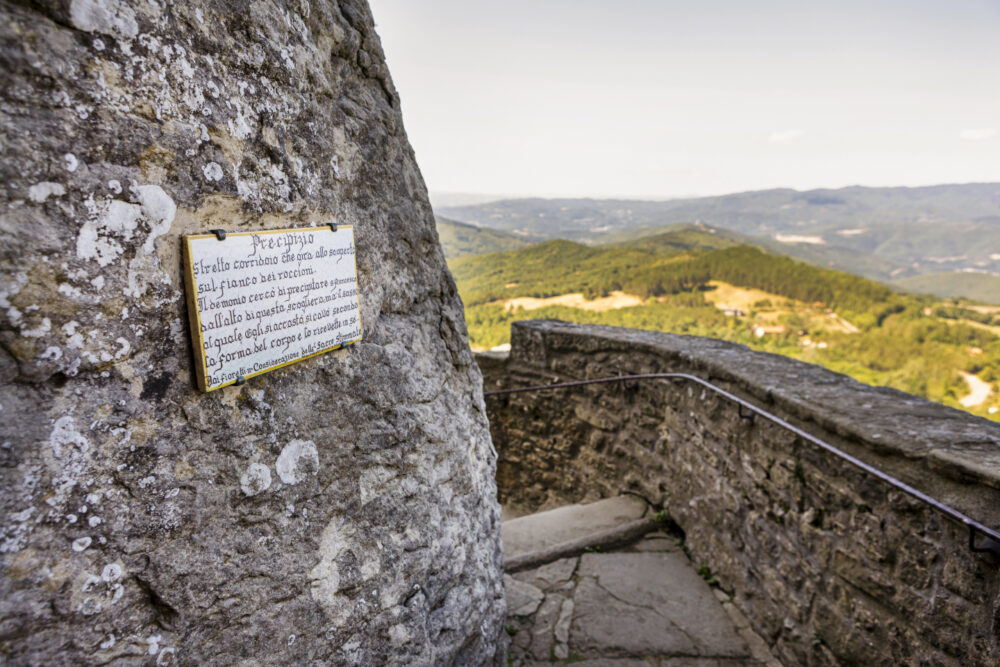Identifying colour on map: brown
As we have noted, the starting point of the Way of Saint Francis in Tuscany is Florence's Basilica di Santa Croce, which was built in 1294 on a convent that had been founded around seventy years before by a group of Franciscan friars. Francis himself, according to the Franciscan Sources, passed through Florence at least once, in 1217.
The Sanctuary of La Verna, at one end of the route, is located a few kilometres from Chiusi della Verna, a tranquil and historic place buried deep in the green National Park of the Casentino Forests.
There are two possible paths from Florence to La Verna, one north and one south. They are described below, and can both be taken to complete a ring route.
Northern Route, passing through the Passo della Consuma
Number of stages: 6
Total distance: 96.5 km
Difficulty: Tourist trail (stage 1) - Hiking trail (stages 2 -6)
Once you reach the top of Monte Calvano and its spectacular 360° view, you descend towards Pieve Santo Stefano, the renowned "City of the Diary". The first stage ends at the Hermitage of Cerbaiolo, a centuries-old Benedictine monastery later given to San Francesco during one of his pilgrimages. It is also where Sant'Antonio found refuge and finished the composition of the Sermons. The hermitage was built around a seventeenth-century cloister and consists of a church, sacristy, refectory, chapel and monastic cells.
The second stage, immersed in greenery, crosses the Alpe della Luna Nature Reserve and leads to the Montagna area. In the next stage, on the road to Sansepolcro, we come across the Hermitage of Montecasale, a place of great importance for having welcomed Francesco in 1213 and remains a remarkable example of the typical architecture.
In Sansepolcro, the village in which Piero della Francesca was born, we find the Civic Museum that preserves some of the painter's great masterpieces and is also home to many churches which boast works by the artists Luca Signorelli, Perugino and Rosso Fiorentino.
The journey then continues towards Anghiari, the splendid medieval village-castle made famous by the "Battle" of the same name painted by Leonardo da Vinci. Here, among other things, we find the Church of the Cross, built right at the point where Francis planted a wooden cross into the ground during one of his return trips from La Verna to Assisi.
Southern Route, through Vallombrosa and Poppi
Number of stages: 6
Total distance: 90.9 km
Difficulty: Hiking trail (stages 1-4, 6) - Tourist trail (stage 5)
The southern way takes walkers out of Florence by hugging the left bank of the Arno river and passing through Rignano sull'Arno, the Abbey of Vallombrosa, Montemignaio, Poppi and Santa Maria del Sasso, just outside of Bibbiena. In part, this route follows the Via Florentia Romana, a centuries-old road that remained important in the Middle Ages both for the number of pilgrims who passed through and for the important commercial exchanges that it facilitated between Florence and the family of the Conti Guidi.
On this path, you come across attractions such as the Spedale del Bigallo, near Bagno a Ripoli, one of many medieval guest houses devoted to welcoming pilgrims and wayfarers, a reminder of the legacy of the Roman era in the town and surrounding area. You can also see the domineering Vallombrosa Abbey, Castel Leone and the Oratory of Santa Maria delle Calle in Montemignaio, and the castle of the Conti Guidi in Poppi.

